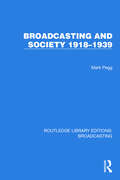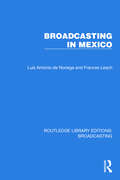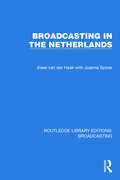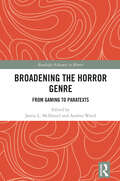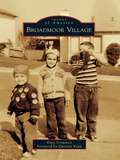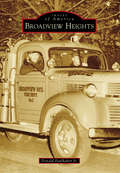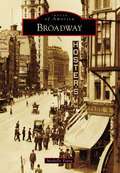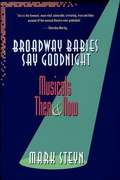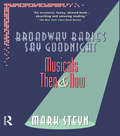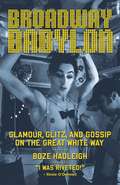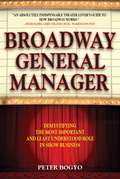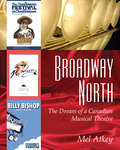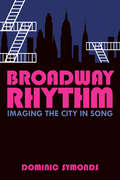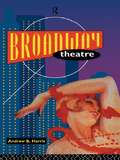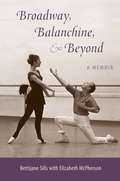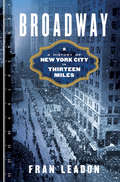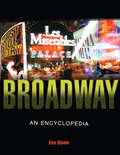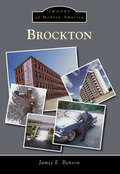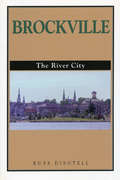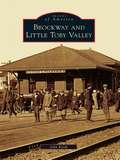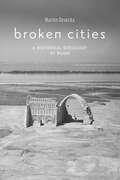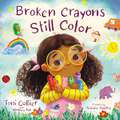- Table View
- List View
Broadcasting and Society 1918–1939 (Routledge Library Editions: Broadcasting #12)
by Mark PeggBroadcasting and Society (1983) examines the power of radio broadcasting as a medium of instant communication and entertainment. It is a detailed and critical examination of the social changes brought about by radio broadcasting in the crucial and formative stages between 1918 and 1939 – whether broadcasting was successful in keeping people better informed, in introducing wider interests, and its influence on social behaviour.
Broadcasting in Canada (Routledge Library Editions: Broadcasting #13)
by E.S. Hallman H. HindleyBroadcasting in Canada (1977) examines the unique challenges to broadcasting in the country: the size of the country, its small, dispersed population, and two official languages make radio and television coverage a difficult and costly enterprise. These conditions and pressures have led Canadians to construct a broadcasting system in which both public and private initiative have roles to play in bringing radio and television services to the community.
Broadcasting in Ireland (Routledge Library Editions: Broadcasting #14)
by Desmond FisherBroadcasting in Ireland (1978) outlines the historical and sociological background of Ireland to place the progress of its broadcasting service in the context of its post-independence development. It analyses the difficulties of running public service broadcasting financed by both licence fee and advertising, and competing in half its television reception area with two of the premier broadcasting systems in the world. With regular broadcasting beginning with Independence, its development was inevitably bound up with the process of building the political, economic and social framework of the new State, and this book closely examines how the Irish broadcasting system coped with the attending economic, cultural and political difficulties.
Broadcasting in Mexico (Routledge Library Editions: Broadcasting #15)
by Luis Antonio de Noriega Frances LeachBroadcasting in Mexico (1979) traces the birth and growth of Mexico’s broadcasting services against the background of its geographical, cultural, demographic, economic and political structure. The development of Mexican radio and television has been characterised by innovation and experiment by both government and private enterprise, and sometimes the country has been the beneficiary of these efforts and sometimes the victim. Up to a certain point, the cultural infrastructure of the country itself dictated the path taken by the media, although there have been temptations to imitate the established structure of other countries.
Broadcasting in the Netherlands (Routledge Library Editions: Broadcasting #16)
by Kees van der Haak Joanna SpicerBroadcasting in the Netherlands (1977) analyses Dutch broadcasting, describing the historical traditions of Dutch society, the ways in which radio and TV were set up, and shows how changes in Dutch politics, culture and economy – as well as technological innovation and liberalisation – have posed a set of challenges for the country.
Broadening the Horror Genre: From Gaming to Paratexts (Routledge Advances in Horror)
by Andrea Wood Jamie L. McDanielThis collection assembles a wide range of scholarship addressing the intersections, influences, and impacts of the horror genre’s proliferation across multiple forms of media.Covering film, television, websites, video games, tabletop and role-playing games, and social media, the volume highlights works from marginalized voices or from less scrutinized media. Building off one of Horror Studies’ traditional homes in film, the volume first features approaches to previously ignored innovations and offshoots related to cinematic and televisual horror, before moving to discuss how horror film conventions inform horror video and tabletop games and how games have started to influence film. Finally, the collection departs the world of film to examine online and non-academic multimodal/cultural discourses about horror, from popular movie reviewers to interactive online marketing and film promotions.This volume will interest scholars and students not only of Horror Studies and genre but also of film, media and television studies, digital media and video games, and transmedia studies.
Broadmoor Village (Images of America)
by Dave CrimmenBroadmoor Village, the little community that embodies the American ethic of independence, survives despite neighboring annexations, budget crises, and even Mother Nature. This subdivision was built in San Mateo County by the Stoneson Company just after World War II, targeting returning veterans and their families. Established before Henry Doelger made neighboring Westlake, Westmoor, St. Francis, and other communities since annexed by Daly City, Broadmoor has repeatedly chosen to stay unincorporated and independent. This attitude has shaped Broadmoor through the years to assert its autonomous stature while surrounded by larger cities.
Broadview Heights (Images of America)
by Donald Faulhaber Jr.Located in southern Cuyahoga County at the crossroads of the Ohio Turnpike and Interstate 77 are the rolling hills and forested landscapes of Broadview Heights. "Highest of the Heights" is the phrase coined by disc jockey Ed Fisher when radio station WGAR's broadcast studio was located in Broadview Heights. Many radio personalities either lived here or in neighboring communities, and events in Broadview Heights were often mentioned on the radio. Part of the Cleveland Metro Parks surrounds the southern edge of town, including the highest point in Cuyahoga County. Among those who call Broadview Heights home are Radio Hall of Fame disc jockey Candy Lee, artist Shirley Aley Campbell, figure skater Tonia Kwiatkowski, and Cultural Olympiad gold medal-winning ice sculptor Aaron Costic of Elegant Ice Creations.
Broadway
by Michelle YoungFrom its origins as a Native American trail to its iconic status in global culture today, Broadway tells the story of New York as it grew from a Dutch colony into a world-class city. Broadway has been the site of many firsts and many superlatives: the first subway line in the city, the tallest buildings, and one of the longest streets in the world. Beginning along the winding streets of the original settlements amid the skyscrapers of the Financial District, Broadway heads north through the neighborhoods of SoHo and Greenwich Village. It then traverses some of the city's most famous plazas, including Flatiron, Herald Square, Times Square, and Columbus Circle, before entering Upper Manhattan and passing institutions like Lincoln Center, Columbia University, and City College. Today, Broadway continues to be at the forefront of New York City's urban developments.
Broadway Babies Say Goodnight: Musicals Then and Now
by Mark Steyn"The Black Crook opened in September 1866" Mark Tells us: Wheatley engineers an implausible marriage between a rotten play and too underdressed coryphees, and, to the delight of all except the usual outraged clergymen, turns in a smash. And, incidentally, winds up inventing the American musical." " [A] witty, anecdote-stuffed history of the past seventy years in musicals." "Steyn deserves a standing ovation.... his prose is as sharp as his stiletto." The book is funny and contains anecdotes, interviews, recollections, and a good snapshot of the music, people, and places that make up the musical. Dry historical facts though this isn't. Nor does every musical get mentioned. You'll look in vein for Paint Your Wagon for example. But for the general reader who would like to learn more about the musicals this is a wonderful book. Steyn traces the history from the musicals birth in 1866 to what he believes to be its death in the 1990s. As a reviewer writes "Mr. Steyn knows the history of Broadway (and West End) musicals, and he makes us care that the current crop lacks conviction and craft." He discusses the musical. Where it came from, Why it works, Why it doesn't work, and who's the best and the worst.
Broadway Babies Say Goodnight: Musicals Then and Now
by Mark SteynThe glorious tradition of the Broadway musical from Irving Berlin to Jerome Kern and Rodgers and Hammerstein to Stephen Sondheim. And then . . . Cats and Les Miz. Mark Steyn's Broadway Babies Say Goodnight is a sharp-eyed view of the whole span of Broadway musical history, seven decades of brilliant achievements the best of which are among the finest works American artists have made. Show Boat, Oklahoma!, Carousel, Gypsy, and more. In an energetic blend of musical history, analysis, and backstage chat, Mark Steyn shows us the genius behind the 'simple' musical, and asks hard questions about the British invasion of Broadway and the future of the form. In this delicious book he gives us geniuses and monsters, hits and atomic bombs, and the wonderful stories that prove show business is a business which -- as the song goes --there's no business like.
Broadway Babylon: Glamour, Glitz, and Gossip on the Great White Way
by Boze HadleighThe first book of theater celebrity gossip, can you believe it? Here's the book that airs Broadway's dirty laundry! Inspired by the classic Hollywood Babylon (in print for more than forty years, more than 100,000 copies sold), Broadway Babylon presents a hyper-entertaining look at the Great White Way's biggest scandals, best-kept secrets, and most over-the-top feuds. Author Boze Hadleigh, the preeminent disher of celebrity dish, serves up 400 pages of tasty, never-before-told stories about such show-biz icons as Ethel Merman, Tennessee Williams, Lucille Ball, Bette Davis, and many, many others. Get it while it's hot!
Broadway General Manager: Demystifying the Most Important and Least Understood Role in Show Business
by Peter Bogyo“An absolutely indispensable theater lover’s guide to how Broadway works.” —Peter Marks, chief theater critic, Washington Post“Highly recommended for those considering theater as a career and for those who love theater and want to know more about what goes on before the curtain goes up and after.” —Library JournalBroadway General Manager is a fascinating, insightful, and entertaining glimpse into the normally closed world of theatrical general management. Penned by veteran Broadway insider Peter Bogyo, readers will gain an appreciation and understanding of what the business half of show business is all about. For the first time ever, gain backstage access to the fast-paced and glamorous world of Broadway. Broadway General Manager is an invaluable resource that examines actual production and operating budgets for a Broadway show and shares contracts for award-winning actors, directors, and designers, all of which are analyzed extensively. Also included are in-depth discussions on such topics as:How to get started as a general manager Negotiating contracts How the producing entity functions Programming the box office The issues related to hiring employees Binding insurance Financial overview Maintaining the run of a show What to do when sales start to slump Closing a show And much more Laced with humorous insights and personal anecdotes, Broadway General Manager will delight both the average theater lover as well as individuals with a serious interest in commercial arts management.
Broadway North: The Dream of a Canadian Musical Theatre
by Mel AtkeyDid you know that the idea behind the Radio City Music Hall Rockettes was first tried out in Toronto? That Canada produced the world’s longest-running annual revue? Few people realize the Canadian influences that are at the heart of American and British culture. Author Mel Atkey’s research for Broadway North included interviews with Norman and Elaine Campbell and Don Harron, creators of Anne of Green Gables-The Musical; Mavor Moore, founder of the Charlottetown Festival and of Spring Thaw; John Gray, author of Billy Bishop Goes to War; Ray Jessel and Marian Grudeff, Spring Thaw writers who had success on Broadway with Baker Street; Dolores Claman, composer of the Hockey Night In Canada theme, who also wrote the musicals Mr. Scrooge and Timber!!; and Galt MacDermot, the composer of Hair who started out writing songs for the McGill University revue My Fur Lady. Included is the phenomenal success of The Drowsy Chaperone. Atkey also draws on his own experience as a writer and composer of musicals, and tells the story of why a show that should have starred James Doohan (Star Trek’s Scotty) didn’t happen. Composer, lyricist and author, Mel Atkey is currently based in the U.K. Proud of his Canadian cultural roots, he has long been fascinated with the notion of a distinctive Canadian musical theatre.
Broadway Rhythm: Imaging the City in Song
by Dominic SymondsBroadway Rhythm is a guide to Manhattan like nothing you've ever read. Author Dominic Symonds calls it a performance cartography, and argues that the city of New York maps its iconicity in the music of the Broadway songbook. A series of walking tours takes the reader through the landscape of Manhattan, clambering over rooftops, riding the subway, and flying over skyscrapers. Symonds argues that Broadway's songs can themselves be used as maps to better understand the city though identifiable patterns in the visual graphics of the score, the auditory experience of the music, and the embodied articulation of performance, recognizing in all of these patterns, corollaries inscribed in the terrain, geography, and architecture of the city. Through musicological analyses of works by Gershwin, Bernstein, Copland, Sondheim and others, the author proposes that performance cartography is a versatile methodology for urban theory, and establishes a methodological approach that uses the idea of the map in three ways: as an impetus, a metaphor, and a tool for exploring the city.
Broadway Theatre (Theatre Production Studies)
by Andrew Harris'Broadway' has been the stuff of theatrical legends for generations. In this fascinating and affectionate account of a unique theatrical phenomenon, Andrew Harris takes an intriguing look at both the reality and the myth behind the heart and soul of American Drama Broadway Theatre explores: * the aims and achievements of such major figures as Tennessee Williams, Eugene O'Neill and David Mamet * the processes a play goes through from preliminary draft to opening night * the careful balancing between aesthetic ideals and commercial considerations * the place of producers, reviewers, agents and managers and their contribution to the process * the relationship between acting styles and writing syles for Broadway plays
Broadway, Balanchine, and Beyond: A Memoir
by Bettijane SillsIn this memoir of a roller-coaster career on the New York stage, former actor and dancer Bettijane Sills offers a highly personal look at the art and practice of George Balanchine, one of ballet’s greatest choreographers, and the inner workings of his world-renowned company during its golden years. Sills recounts her years as a child actor in television and on Broadway, a career choice largely driven by her mother, and describes her transition into pursuing her true passion: dance. She was a student in Balanchine’s School of American Ballet throughout her childhood and teen years, until her dream was achieved. She was invited to join New York City Ballet in 1961 as a member of the corps de ballet and worked her way up to the level of soloist. Winningly honest and intimate, Sills lets readers peek behind the curtains to see a world that most people have never experienced firsthand. She tells stories of taking classes with Balanchine, dancing in the original casts of some of his most iconic productions, working with a number of the company’s most famous dancers, and participating in the company’s first Soviet Union tour during the Cold War and Cuban Missile Crisis. She walks us through her years in New York City Ballet first as a member of the corps de ballet, then a soloist dancing some principal roles, finally as one of the “older” dancers teaching her roles to newcomers while being encouraged to retire. She reveals the unglamorous parts of tour life, jealousy among company members, and Balanchine’s complex relationships with women. She talks about Balanchine’s insistence on thinness in his dancers and her own struggles with dieting. Her fluctuations in weight influenced her roles and Balanchine’s support for her—a cycle that contributed to the end of her dancing career. Now a professor of dance who has educated hundreds of students on Balanchine’s style and legacy, Sills reflects on the highs and lows of a career indelibly influenced by fear of failure and fear of success—by the bright lights of theater and the man who shaped American ballet.
Broadway: A History Of New York City In Thirteen Miles
by Fran LeadonAn eye-opening history of Manhattan told through its most celebrated street. In the early seventeenth century, in a backwater Dutch colony, there was a wide, muddy cow path that the settlers called the Brede Wegh. As the street grew longer, houses and taverns began to spring up alongside it. What was once New Amsterdam became New York, and farmlands gradually gave way to department stores, theaters, hotels, and, finally, the perpetual traffic of the twentieth century’s Great White Way. From Bowling Green all the way up to Marble Hill, Broadway takes us on a mile-by-mile journey up America’s most vibrant and complex thoroughfare, through the history at the heart of Manhattan. Today, Broadway almost feels inevitable, but over the past four hundred years there have been thousands who have tried to draw and erase its path. Following their footsteps, we learn why one side of the street was once considered more fashionable than the other; witness the construction of Trinity Church, the Flatiron Building, and the Ansonia Hotel; the burning of P. T. Barnum’s American Museum; and discover that Columbia University was built on the site of an insane asylum. Along the way we meet Alexander Hamilton, Emma Goldman, Edgar Allan Poe, John James Audubon, "Bill the Butcher" Poole, and the assorted real-estate speculators, impresarios, and politicians who helped turn Broadway into New York’s commercial and cultural spine. Broadway traces the physical and social transformation of an avenue that has been both the "Path of Progress" and a "street of broken dreams," home to both parades and riots, startling wealth and appalling destitution. Glamorous, complex, and sometimes troubling, the evolution of an oft-flooded dead end to a canyon of steel and glass is the story of American progress.
Broadway: An Encyclopedia
by Ken BloomThis volume is another example in the Routledge tradition of producing high-quality reference works on theater, music, and the arts. An A to Z encyclopedia of Broadway, this volume includes tons of information, including producers, writer, composers, lyricists, set designers, theaters, performers, and landmarks in its sweep.
Brockton: The 1941 Brockton Tragedy And The Fallen Thirteen (Images of Modern America)
by James E. BensonBrockton, first settled in 1700, was originally a part of Old Bridgewater, known as North Parish and later as North Bridgewater. On April 9, 1881, it officially became the City of Brockton. During the Civil War, Brockton was the largest producer of shoes in the country, earning it the nickname "Shoe City." As a growing industrial center, Brockton had the proud honor of being first in the world and nation in many ways. On October 1, 1883, the city became the first in the world to have a three-wire underground electrical system, initially turned on by Thomas Edison. In 1884, the Central Fire Station became the first electrically operated fire station in the country. In 1894, the City Theater had the distinction of being the first in the world tied to a three-wire underground system. In 1890, Col. James Edgar, owner of Edgar's Department Store, donned a Santa Claus outfit, becoming the first department store likeness of the jolly old man. Brockton is also known as the "City of Champions," being the hometown of boxing greats Rocky Marciano and Marvelous Marvin Hagler.
Brockville: The River City
by Russ DisotellBrockville’s origins reach back to the resettlement of Loyalists following the American Revolution and the threat of American encroachment. Following the War of 1812, Brockville, along the St. Lawrence River, benefitted greatly from the rapidly expanding colonization. A centre for the political activity of the day and a focal point for the Orange movement, Brockville was often immersed in controversy.The end of the 19th century was the golden age of patent medicine business and Brockville was home to two of the most successful, the W. H. Comstock Company and the G. T. Fulford Company. "Pink Pills for Pale People" were sold worldwide. Today, Brockville retains the charm of its heritage mansions and is home to a number of prominent industries.
Brockway and Little Toby Valley
by John KeithBrockway, originally called Brockwayville until the name was shortened in 1925, is named after the Brockway family pioneers who settled near the southern bend of Little Toby Creek in 1822. The Brockways were followed by several other settlers, including the "Father of Brockway," Dr. Asaph M. Clarke, who laid out the town in 1836. Farming and lumbering were the original industries, but by 1883, coal mining had brought in the railroads. Railroads introduced more industry, the most famous being the Brockwayville Machine Bottle Company in 1907. Through images from the Brockway Area Historical Society, Brockway and Little Toby Valley chronicles the development of this industrious community.
Broken Boxes: A Decade of Art, Action, and Dialogue
by Ginger Dunnill Josie LopezBroken Boxes: A Decade of Art, Action, and Dialogue celebrates ten years of Ginger Dunnill’s podcast of the same name and exalts the intersectionality of contemporary artists. Intersectionality studies the overlapping and intersecting social identities and related systems of oppression, domination, and discrimination. Here are twenty-three extraordinary artists bringing the creativity of their processes and identities to life in the Albuquerque Museum’s exhibition and in this accompanying book. Broken Boxes delves deeply into the realm of intentionality, challenging not just how artists create, but why. And Broken Boxes—the podcast, the exhibition, and the book—thrives on bringing artists together in dialogue with each other through the artist’s own words. This book provides an opportunity to introduce the larger public to artists committed to creating, sustaining, and encouraging solidarity. By opening up the conversations across communities, groups, art practices, materials, and shared space, we hope to demonstrate how artists are forging new forms of action.
Broken Cities: A Historical Sociology of Ruins
by Martin DeveckaA comparative study of cities that fell into ruin through human involvement.We have been taught to think of ruins as historical artifacts, relegated to the past by a catastrophic event. Instead, Martin Devecka argues that we should see them as processes taking place over a long present. In Broken Cities, Devecka offers a wide-ranging comparative study of ruination, the process by which monuments, architectural sites, and urban centers decay into ruin over time. Weaving together four case studies—of classical Athens, late antique Rome, medieval Baghdad, and sixteenth-century Mexico City—Devecka shows that ruination is a complex social process largely contingent on changing imperial control rather than the result of immediate or natural events. Drawing on literature, legal texts, epigraphic evidence, and the narratives embodied in monuments and painting, Broken Cities is an expansive and nuanced study that holds great significance for the field of historiography.
Broken Crayons Still Color
by Toni Collier Whitney BakHelp your kids process big feelings, build a social-emotional tool kit, and find beauty in life's challenges with this creative story that expresses the hope of the gospel from podcast host, speaker, and mom Toni Collier.Avery has big emotions and bubbling anxieties about changes in her life. When her crayons break as she scribbles furiously, she discovers that they have personalities and feelings too! And they can show her how to use her love of coloring to manage scary, overwhelming feelings and embrace curiosity and joy. As Avery follows the crayons' advice, gets creative, and chooses bravery and positive thinking, she discovers that God can use her to make beautiful things, even with broken crayons.In Broken Crayons Still Color, children 4 to 8 willsee that everyone feels frustrated and overwhelmed at timeslearn to express emotions and explore creativitypractice coping skills, such as drawing worries, affirmations, and breathingunderstand that God loves them just as they are and He can turn their mistakes and weaknesses into beautiful new thingsThis illustrated picture book includesan inventive illustration style that models to children how to draw their own feelingsan emotion color chart to guide children in identifying how they feelWith a fun story, silly crayon characters, and practical guidance for kids struggling with powerful emotions, insecurity, and perfectionism, Broken Crayons Still Color will entertain children as it assures them that God is making a beautiful masterpiece out of things they thought were broken. The presentation page and deluxe dust jacket make this encouraging book a beautiful gift for back-to-school, kids facing new experiences and tough situations, and any child with big feelings.
